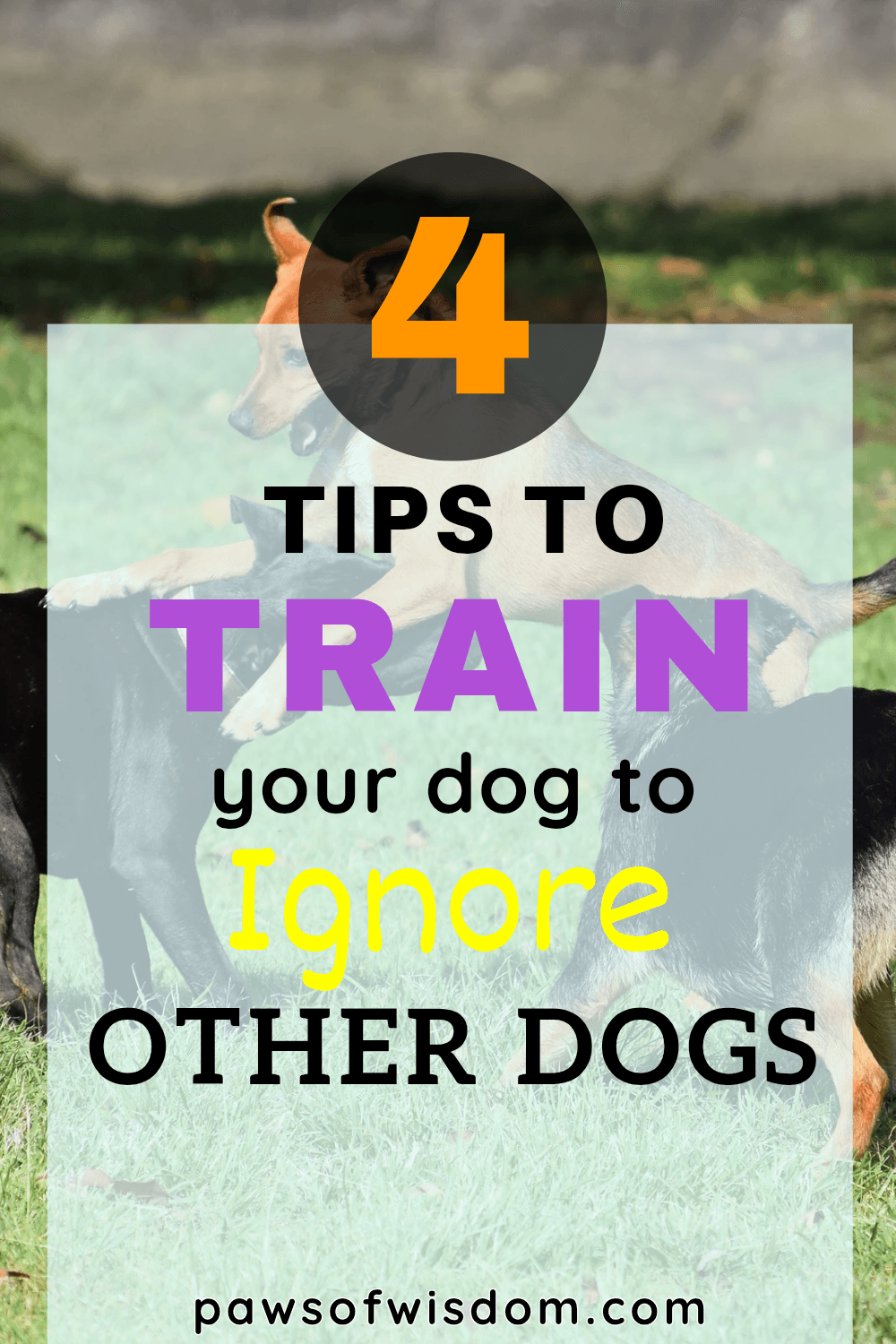Training Your Dog to Ignore Other Dogs: Why It Matters
If you’re trying to walk your dog without them barking, lunging, or locking onto every dog that passes…then welcome to the club.
Training your dog to ignore other dogs can feel impossible at the best of times — especially when every walk turns into a chaotic train wreck of mixed emotions and tension.
Whether your dog is reactive, frustrated, or just wildly social, the skill of neutrality changes everything. It’s not about forcing obedience. It’s about giving your dog the tools to feel calm, safe, regulated, connected and in control — even when other dogs are around.
In this post, I'll help you shift the goal from “be nice” to “just be” — and explore how to help your dog stay grounded, engaged, and regulated around the very thing that currently unravels them.
I’ll dive into why neutrality matters, how poor socialisation plays a role in excitement and reactivity, and five actionable methods you can start using on your next walk to help your dog feel less overwhelmed and more focused so you can finally start enjoying walks again.

Training Your Dog to Ignore Other Dogs Isn’t About “More Socialisation” — It’s About the Right Kind of Exposure
When people search how to train a dog not to bark at other dogs or how to stop a dog reacting to other dogs, the common advice is often to "socialise" more. Now this is right, but socialisation is one of the most misunderstood words in terms of dog training and most owners end up making the same mistake because of this.
When most people hear socialisation, they think of human socialising — meet-ups, playdates, dog parks, cafes and brunches. But in the dog world socialisation isn’t actually about interaction. It’s about controlled and positive exposure that helps your dog feel safe and regulated in their environement and around other dogs without the pressure to engage.
Standing at a distance where your dog can see other dogs, but remain calm and curious, is socialisation. Taking them to chaotic dog park environments? That’s flooding, and for many reactive, anxious, or frustrated dogs, this just adds more fuel to the fire.
This is why I actually prefer the term neutrality, because what we want isn't just "getting along" — it’s being able to exist calmly (and without a meltdown).
If your dog is constantly reacting, lunging, barking, or struggling to keep it together around other dogs, more socialising won’t fix the problem. In fact, it could be making things worse.

Why Should You Focus on Training Your Dog To Ignore Other Dogs?
If you're working with a reactive dog — whether it's fear-based, frustration, or just sheer overexcitement — you probably already know why training your dog to ignore other dogs is so important. The funny thing is...it’s not just reactive dogs that benefit from this skill. Even those happy-go-lucky, social butterfly types can end up struggling without it.
Right now, your dog might seem fine — eager to meet other dogs, pulling on the lead to say hello. It feels harmless…maybe even like you’d be holding them back by not letting them “be social.”
But have you realised that what often feels like harmless fun in the moment can actually create long-term behaviour issues down the line? (if not spoiler warning...)
Letting your dog constantly interact with other dogs, especially on walks, can lead to:
Pulling and lunging to reach other dogs
Increased frustration and arousal when they can’t get to what they want
More impulsive behaviour
Reactivity — barking, jumping, or over-the-top behaviour when they see dogs from a distance

I've been there myself. Jasper absolutely loves people, and in the early days, I made the mistake of letting him interact with everyone and anyone, what was the worst that could happen?
What I didn’t realise was that I was feeding into his overarousal and making our walks worse. He wasn’t interested in sniffing, exploring, or decompressing — he was only focused on the next interaction. It put him in the wrong mindset before the walk even began.
The result? Walks became frustrating for both of us and it took far longer to undo that cycle than it would have to avoid it in the first place.
This is why learning how to build calm, neutral behaviours around other dogs is such an important piece of the puzzle — not just for reactive dogs, but for any of those who struggle to regulate their excitement or emotions.
5 Essential Strategies to Help Your Dog Ignore Other Dogs (Without Chaos or Overwhelm)
#1 - Prioritise Engagement First
Before we ask our dogs to ignore others, we need to make sure they want to and can engage with us first. Engagement isn’t just about getting eye contact past a trigger, it's about building a real world partnership.
If your dog is constantly scanning, pulling, or zoning out on walks, it usually means the world is more exciting or overwhelming than you are in that moment.
Engagement shift your dog’s focus and trust onto you...especially in those tough times.
Start small. Use fun movement, games, treats, and tone changes. Reward any moment they check in with you (even if it’s just a glance). Over time, these micro-moments build into a strong foundation.

#2 - Teaching Calm Through Neutrality (Socialisation Done Right)
As mentioned, many owners think socialisation means their dog should meet everyone and everything, which can be problematic, evenif it's not noticeable until further down the line.
Neutrality on the other hand involves exposing your dog to triggers at a safe distance where they can observe without reacting. It teaches them that they don’t need to respond to every trigger, situation and stimulus. They don’t need to pull, lunge, or even say hello.
They can just be...
This is one of the most empowering skills you can give a dog. It builds confidence and resilience, reduces stress, teaches regulation, and gives you both space to just breathe.
Best of all — it’s simple. Find a quiet spot, let your dog watch the world, and reward calm choices.
#3 - Meet Their Needs First (Before You Even Step Outside)
You can’t expect calmness on a walk (or in general) if your dog’s needs aren’t being met. So many dogs are labelled as "reactive" or "frustrated", or "hyperactive" simply because they’re unregulated and are carrying too much frustration and energy.
Before any training session or walk, ask yourself:
Has my dog had time to decompress recently?
Have I given them a chance to use their brain or body today?
Are they calm enough to focus on me?
Will this make things beter or worse for my dog right now?
Outlets like sniffing, chasing, bitework, swimming, spring pole, tracking, ball games, scentwork (and so forth) are gold!
They tap into your dog’s natural drives and give them the mental and emotional release they crave. Once those needs are satisfied, your dog is far more likely to act less impulsively, make better choices and listen to direction.
If your dog’s constantly “on,” they don’t need more walks — they need better outlets.
👉🏾 [Grab the FREE Paws Of Wisdom Breed Specific Outlets Guide] and learn how to work with their instincts, not against them.
Only available in the Regulators Community Resource Vault!
#4 - Avoid Piling on Pressure (Trigger Stacking)
No one thrives under constant pressure — especially not dogs. If your walks are constantly filled with triggers, your dog isn’t going to be learning; they’re surviving, slowly becoming more and more overwhelmed.
When pressure (the unholy trinity — stress, overstimulation, frustration) isn't regulated on a daily basis it builds and spills into the next day. As pressure builds and a dog becomes dysregulated they become more impulsive, erratic, anxious, hyperactive until they finally explode.
Reducing exposure doesn’t mean hiding from the world. It means being intentional. Choosing the routes with fewer dogs. Creating distance when needed. Walking at quieter times. Taking a break from walks and meeting needs another way. These aren’t shortcuts...they’re smart training decisions.
Think of it as setting your dog up for success. Once they’re confident in low-pressure environments, then you can slowly add challenges.
Not before.

#5 - Focus on Decompression and Recovery
Decompression is the missing piece in many training and behaviour modification plans.
Without enough rest, your dog stays on edge, alert, their nervous system constantly activated. You may be doing everything “right” and still seeing no progress but this could be because stress hasn’t been addressed.
Decompression means rest days, slow sniffy walks, quiet time at home, more structure, and reducing the number of stress an triggers your dog is exposed to.
It’s not a luxury — it’s a requirement.
Dogs need space to recover, process, and regulate. Once you prioritise decompression, you’ll likely see faster progress, fewer meltdowns, and a dog who can actually learn and make the right decisions instead of just constantly reacting on impulse.
👉🏾 Not sure if you’re helping or overwhelming your dog?
The FREE Paws Of Wisdom Socialisation Guide breaks it down step by step — including safe exposure, what to avoid, and how to build calm without chaos.
Only available in the Regulators Community Resource Vault!
Quick Recap: Which Approach Will You Start With?
If you're feeling overwhelmed, don’t worry. You don’t have to do everything at once, that's how you get burned out.
Start with one method that feels most doable and build from there...
Need more focus on walks? Start with Engagement.
Struggling with chaos around dogs? Try Building Neutrality.
Is your dog overstimulated before the walk even starts? Meet Their Needs First.
Constant reactions or blow-ups? Manage Exposure and Avoid Triggers.
Want lasting results? Prioritise Rest, Structure & Good Habits
Turn Strategy Into Progress With the Digital Dog Journal
Keeping track of what’s working, what’s not, and how your dog is actually coping? No? See that’s actually the secret sauce most people skip.
Tracking and reflecting on your dog’s progress is genuinely one of the most empowering things you can do. It gives you clarity when your brain is fried, helps you notice patterns you’d otherwise miss, and shows you the wins that don’t always feel obvious.
Like this:
You realise your dog barked way less this week and is starting to sleep more.
You scroll back through the Journal and see you added more outlet work, walked earlier in the day, and swapped your route to a quieter street. That’s progress. That’s something you can build on.
My Digital Dog Training Journal and Progress Tracker helps you track:
Daily patterns, wins, and meltdowns
What strategies you’ve tried — and what actually helped
Your dog’s energy, triggers, and progress across time
Unwanted behaviours and trigger tracker
It’s not just a tracker.
It’s a way to stay grounded, reflect clearly, and move forward without second-guessing yourself every week.
It's a way to grow. Track patterns you wouldn't usually notice. Zoom out and see where you're actually going.
Final Thoughts
This work isn’t just about helping your dog ignore other dogs.
It’s about helping them feel regulated enough not to react. It’s about building a relationship where they not only make good decisions but trust you to guide the moment — so they don’t have to go into pshycopath mode every time another dog shows up.
When you start to focus on meeting their needs, reducing stress, and teaching the skill of neutrality, everything else becomes that little bit easier. The lunging, barking, pulling — it all starts to fade when your dog feels regulated enough to think clearly and choose not to react.
Whether your dog is barking out of fear, pulling out of excitement, or spiralling into frustration and chaos, there is a way through.
It’s not instant. And it’s definitely not linear. But the change happens in these small, consistent shifts — neutrality over novelty, recovery over repetition, engagement over obedience drills.
Every calm glance. Every check-in. Every walk that doesn’t end in chaos — it all counts.
You’ve got this. And your dog does too!
Frequently Asked Questions (FAQs): Dog Reactivity, Neutrality, and Walks
Start by building engagement and focus in low distraction environments such as at home or your back garden. Teach your dog to check in with you regularly. The start building your foundation in quiet environments and slowly increase the difficulty by adding distance exposure to other dogs. Consistency, structure, and neutral experiences are key.
Use a leash. That is literally what it's there for. A leash can help manage distance and teach impulse control. If your dog constantly runs up to other dogs they are reinforcing the behaviour. You want to reinforce calm behaviour and redirect your dog’s attention to you before they fixate. Practice structured walks, and avoid areas with high off leash dog traffic while you’re training.
Gradually expose your dog to other dogs from a safe distance that they can cope with and remain calm. Reward relaxed behaviour and slowly decrease the distance over time. This approach, known as desensitisation and counter-conditioning, helps your dog feel more neutral.
Focus on engagement, decompression, and neutrality. If your dog is over threshold then you need to increase distance from triggers. Train in calm environments first, and slowly build up your dog’s confidence and coping skills through repetition, good experiences, and positive reinforcement.
Your dog may be reacting out of excitement, frustration, fear, or stress. This usually stems from poor social experiences, lack of boundaries, or unmet needs. Understanding the why behind your dog’s behaviour is the first step to changing it.
Related Reading
A FREE community with downloadable guides and resources, and people who get it.
A simple and structured reset for overstimulated, dysregulated, chaotic dogs.
Simple, clear guidance to help you understand your dog through a regulation-first lens.











